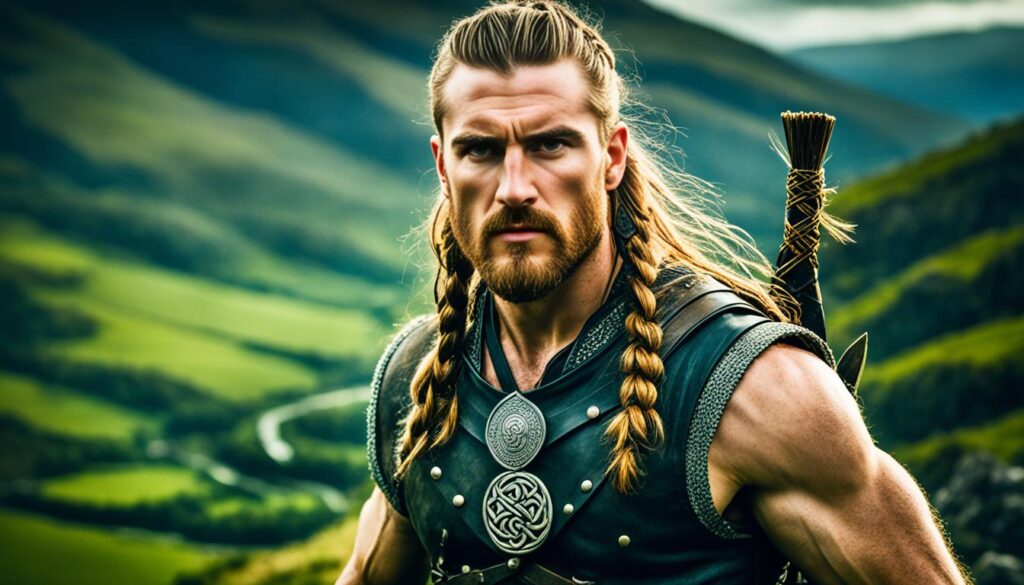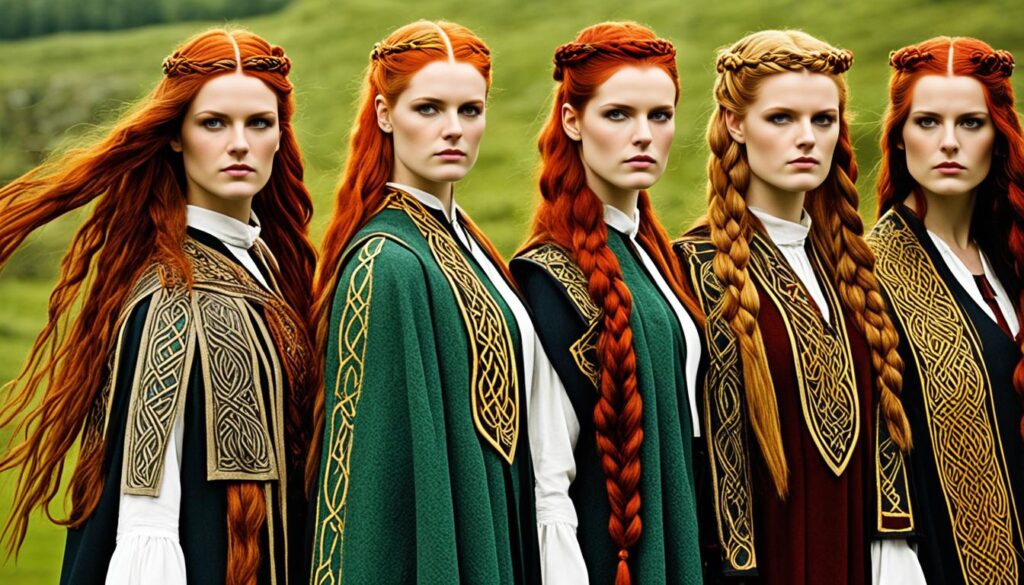
When we think of ancient Celtic culture, images of warriors, druids, and mystical landscapes often come to mind. But what about their hair? Did the Celts have a unique approach to grooming and hairstyling? Specifically, did they braid their hair?
The Celts were known for their long hair, both men and women, but what about braids? Were braids a part of their grooming practices? And if so, what did these braids look like? Were they intricate and ornate, reflecting the culture’s rich artistic traditions?
In this article, we will explore the ancient Celtic hair traditions, uncovering the historical significance of braiding and its role in Celtic culture. We will delve into the different braided styles worn by both men and women, their symbolic meanings, and the overall grooming practices of the Celts.
Ready to uncover the secrets behind the Celts’ hair styling habits? Let’s begin our journey into the fascinating world of Celtic hairstyles.
Key Takeaways:
- The Celts wore their hair long, both men and women.
- Braids were a common hairstyle for Celts, adorned with decorative pins, beads, ribbons, and precious metals.
- Female Celts had elaborate braided styles, often indicating different class ranks.
- Male Celts, especially warriors, braided their hair and beards to appear tough and intimidating in battle.
- Celtic hair color held symbolic significance, with different colors representing different connections and powers.
Celtic Hairstyles: Women’s Braided Styles
Female Celts embraced intricate braided hairstyles that not only showcased their creativity but also served a practical purpose of keeping their hair in place during their daily activities. One of the popular and visually stunning Celtic braided styles for women is the Celtic knot braid. This style pays homage to the interwoven patterns found in traditional Celtic art, reflecting the rich cultural heritage of the Celts.
Another charming Celtic braided style for women involved three braids elegantly wrapped around the head, with a fourth braid cascading down the back. The combination of these braids created a captivating and regal appearance, symbolizing femininity and grace.
| Characteristics of Celtic Women’s Braided Styles | Symbolism |
|---|---|
| Elaborate braided hairstyles | Emphasized sophistication and status |
| Adorned with ribbons, beads, and balls | Enhanced beauty and individuality |
| Class distinctions reflected in the braided styles and adornments | Signified social hierarchy and noble lineage |
These braided styles were not only fashionable but also conveyed important messages about a woman’s social status and heritage within Celtic society. The intricate braids, supplemented with ribbons, beads, and balls, added a touch of personal style while capturing the essence of the Celtic women’s hairstyles.
Celtic Knot Braid
“The Celtic knot braid is a mesmerizing symbol of Celtic art, intertwining intricate patterns that represent the eternal cycles of life and nature. It’s a testament to the Celts’ craftsmanship and their ability to incorporate complex designs into everyday elements of life, such as hairstyles.”
These awe-inspiring braided styles continue to inspire modern interpretations and have become iconic representations of Traditional Celtic hairstyles. Today, many women pay homage to their Celtic heritage by embracing Celtic braids as a way to both honor their ancestry and showcase their unique sense of style.
Celtic Hairstyles: Men’s Braided Styles
Celtic men also embraced braided hairstyles, particularly warriors who wanted to appear tough and intimidating in battle. They would often braid their long hair and even their beards. Beard braids were simple, with a few strands braided and adorned with hair rings. Braided hairstyles were a common sight in Celtic settlements and were not limited to any gender.

Throughout Celtic culture, men valued braided hairstyles as a symbol of strength and bravery. Warriors adorned their long hair with intricate braids to showcase their prowess in battle. The braids not only added to their intimidating presence but also served a practical purpose of keeping their hair out of their faces during combat.
One popular braided style among Celtic men was the warrior braid, a simple yet striking design that involved braiding several strands of hair together. These braids were often adorned with hair rings or beads, adding decorative flair to the rugged look.
“Braided hairstyles were a common sight in Celtic settlements and were not limited to any gender.”
While braids were commonly seen among warriors, men from various walks of life embraced this hairstyle as well. From farmers to craftsmen, the men of Celtic society incorporated braids into their daily grooming routines, reflecting their pride in their Celtic heritage.
In addition to braiding their hair, Celtic men also braided their beards. Beard braids were a symbol of maturity and wisdom, and they were often worn by elder warriors who commanded respect and admiration within their communities.
The practice of braiding hair, both on the head and the beard, was not limited to any specific tribe or region. It was a shared tradition that highlighted the unity and common cultural practices within the Celtic civilization.
As with the women’s braided styles, the braids of Celtic men were not simply utilitarian but were also used as a means of self-expression and personal adornment. Through their hairstyles, Celtic men showcased their identity, strength, and allegiance to their Celtic roots.
Hair Color Symbolism and Hair Length in Celtic Culture
Hair color held significant symbolism for the Celts. Brunettes were associated with a terrestrial connection, blondes were believed to have a closer connection to the gods, redheads were seen as having magical powers, and silver hair was seen as a connection between the earthly and spiritual realms.
The Celts attributed different meanings to hair color, associating it with various qualities and characteristics. Brunettes were often seen as grounded and connected to the earth, representing stability and practicality. Blondes, on the other hand, were believed to possess a divine connection, symbolizing purity and spirituality. Their hair color was thought to indicate a closer relationship with the gods.
“The Celts held a strong belief in the spiritual significance of hair color. It was not merely a matter of aesthetics but rather held deeper meaning and symbolism in their culture.”
Redheads were regarded as particularly powerful and magical individuals. Their vibrant hair symbolized their connection to the supernatural, and they were often revered and feared for their supposed abilities. Silver hair, associated with old age and wisdom, represented a bridge between the mortal realm and the spiritual world.
Furthermore, hair length played a crucial role in Celtic culture. Cutting a man’s hair and beard was considered disgraceful and served as a punishment for breaking tribal laws. Long hair and beards were seen as symbols of masculinity, strength, and honor, particularly among Celtic warriors.
The Celts had a deep appreciation for the symbolism of hairstyles and their cultural significance. They believed that hairstyles, including the use of braids, could convey important messages about an individual’s identity, social status, and connection to the spiritual realm.
Celtic Warrior Hairstyles
Celtic warriors often showcased their fierce reputation through their hairstyles. They would braid their long hair and even their beards, creating intricate and elaborate styles. These braided hairstyles were designed to intimidate enemies and showcase their strength and valor in battle.
The use of braids in Celtic warrior hairstyles not only served a practical purpose by keeping hair out of the warriors’ faces during combat but also held symbolic significance. Braids were seen as a sign of virility and warrior spirit, distinguishing warriors from other members of Celtic society.
Additionally, Celtic warriors would adorn their braided hairstyles with various accessories such as beads, feathers, and metal rings, further emphasizing their status and prowess on the battlefield.
Celtic Hair Color Symbolism and Meanings
| Hair Color | Symbolism/Meaning |
|---|---|
| Brunette | Terrestrial connection, stability, practicality |
| Blonde | Divine connection, purity, spirituality |
| Redhead | Magical powers, supernatural connection |
| Silver | Connection between earthly and spiritual realms, wisdom |
The table above illustrates the various hair colors in Celtic culture and their associated symbolism and meanings. These beliefs and interpretations of hair color played an essential role in Celtic society, influencing their perceptions of individuals and shaping their cultural practices.

Conclusion
In Celtic culture, hairstyles played a significant role in expressing identity and communicating social status. Historical Celtic braiding was a common practice among both men and women, reflecting the Celts’ intricate grooming traditions. By braiding their hair, Celts showcased their creativity and craftsmanship, turning their hair into a canvas for self-expression.
Moreover, Celtic hairstyles held symbolic meanings that tied into their spiritual beliefs. Hair color and length were associated with different connections and powers. From brunettes with a terrestrial connection to silver-haired individuals bridging the earthly and spiritual realms, each hair color held its own significance in Celtic culture.
Not limited to any particular gender or tribe, braided hairstyles were widely embraced by Celtic communities. Whether it was the intricate Celtic knot braids worn by women or the warrior braids donned by men, these styles represented both aesthetics and cultural values.
Today, the historical Celtic braiding tradition continues to inspire modern hairstyles, showcasing the timeless beauty of Celtic culture. From adorned braids in contemporary fashion to the revival of traditional styles, the significance of hair in Celtic culture endures, weaving together history and artistry.






